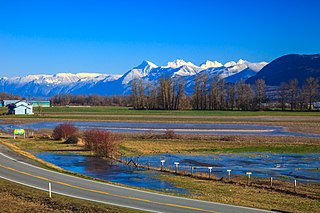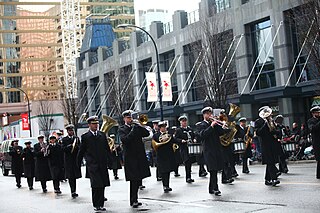
Chilliwack is a city in the province of British Columbia, Canada. It is located 102 kilometres (63 mi) east of Vancouver off the Trans Canada Highway. Historically an agricultural community, Chilliwack's population is now primarily suburban. The Fraser Valley Regional District is headquartered in Chilliwack, which is the Fraser Valley's second largest city after Abbotsford. Chilliwack is surrounded by mountains and home to recreational areas such as Cultus Lake and Chilliwack Lake Provincial Parks. There are many outdoor activities in the area, including hiking, rock climbing, mountain biking horseback riding, whitewater kayaking, camping, fishing, golf and paragliding.
Canadian Forces Base Borden, formerly RCAF Station Borden, is a large Canadian Forces base located in Ontario. The historic birthplace of the Royal Canadian Air Force, CFB Borden is home to the largest training wing in the Canadian Armed Forces. The base is run by Canadian Forces Support Training Group (CFSTG) and reports to the Canadian Defence Academy (CDA) in Kingston.

Canadian Forces Base Kingston is a Canadian Forces Base operated by the Canadian Army located in Kingston, Ontario.

Royal Canadian Air Force Base Shearwater, commonly referred to as RCAF Shearwater, was a Canadian Forces base located 4.5 nautical miles east southeast of Shearwater, Nova Scotia, on the eastern shore of Halifax Harbour in the Halifax Regional Municipality. Following a base rationalization program in the mid-1990s, the Canadian Forces closed CFB Shearwater as a separate formation and realigned the property's various facilities into CFB Halifax. These include:

A Canadian Forces base or CFB is a military installation of the Canadian Armed Forces. For a facility to qualify as a Canadian Forces base, it must station one or more major units.
5th Canadian Division Support Base Gagetown, formerly known as and commonly referred to as CFB Gagetown, is a large Canadian Forces Base covering an area over 1,100 km2 (420 sq mi), located in southwestern New Brunswick.

Canadian Forces Base Esquimalt is Canada's Pacific Coast naval base and home port to Maritime Forces Pacific and Joint Task Force Pacific Headquarters. As of 2018, 4,411 military personnel and 2,762 civilians work at CFB Esquimalt.
3rd Canadian Division Support Base Detachment Wainwright, commonly referred to as Canadian Forces Base Wainwright or CFB Wainwright, is a Canadian Forces Base located in Denwood, Alberta, adjacent to the town of Wainwright.

CFB Edmonton is a Canadian Forces base located in Sturgeon County adjacent to the City of Edmonton in Alberta, Canada. It is also known as Edmonton Garrison or "Steele Barracks".

The Canadian Military Engineers is the military engineering personnel branch of the Canadian Armed Forces. The members of the branch that wear army uniform comprise the Corps of Royal Canadian Engineers.
Canadian Forces Base Toronto is a former Canadian Forces base in Toronto, Ontario. The airfield is currently operated as Toronto / Downsview Airport.

In the Canadian Forces, Maritime Forces Pacific is responsible for the fleet training and operational readiness of the Royal Canadian Navy in the Pacific Ocean. It was once referred to as Canadian Pacific Station.
6 Engineer Squadron is a Primary Reserve Canadian Military Engineer unit of the Canadian Forces. 6 Engineer Squadron is part of the 39 Canadian Brigade Group, headquarters for all Primary Reserve units in British Columbia. 6 Engineer Squadron is a sub unit of 39 Combat Engineer Regiment.
Canadian Forces Europe was the Canadian Forces military formation in Europe during the Cold War. The CF assisted other NATO allies in watching the military activities of Warsaw Pact and the Soviet Union.
Area Support Unit Chilliwack is a Canadian Forces facility located in Chilliwack, British Columbia.
The Canadian Forces School of Military Engineering (CFSME), located at CFB Gagetown in Oromocto, New Brunswick is responsible for the conduct of 85 different courses that span all ranks and occupations within the Combat Engineering and Construction Engineering organizations. CFSME is the Canadian Forces Centre of Excellence in military engineer Training.
Vedder Crossing is adjacent to the junction of the Chilliwack and Vedder Rivers at its southern boundary, and Promontory Road to the north.
The following is a hierarchical outline for the Canadian Armed Forces at the end of the Cold War. It is intended to convey the connections and relationships between units and formations.

The Naden Band of the Royal Canadian Navy is one of six regular force military bands of the Canadian Forces. The Royal Canadian Navy band is based at CFB Esquimalt in Esquimalt, British Columbia that serves as the official musical unit of the Canadian Forces Maritime Forces Pacific Command (MARPAC).
The Band of the Royal Canadian Engineers was a Canadian Army military band that served briefly for 15 years from 1953 to 1968. During its entire existence, it was based in Chilliwack, British Columbia. It was the premier band in the RCE, having precedence over other small unit bands such as the Band of the 48th Squadron. It was established at the Royal Canadian School of Military Engineering and primarily recruited from a mix of Canadian nationals as well as musicians from the United Kingdom, the Netherlands and Hungary. It has performed for members of the Canadian royal family as well as Governors General of Canada. In September 1964, the band performed during the arrival of U.S. President Lyndon B. Johnson in Vancouver for the Columbia River Treaty ceremonies. 1967 marked a busy schedule for the band. In this year, it performed during Expo 67, the Seattle Armed Forces Pageant, and the Centennial Grand Military Tattoo. Due to a mass reorganisation of Canadian military bands across the military services that came as a result of the Canadian Forces unification, the band was dissolved in 1968. It was lastly directed by Captain Leonard Camplin, who began his service with the band in 1961.











